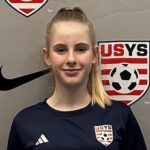What message do we send when we call our injured players warriors?
 Don’t you love the P&G Brand (Raising an Olympian) commercials? They end with, “Thank you mom for teaching us that falling makes us stronger. For giving us the encouragement to try again.” They had me at “Oops. Up you go.”
Don’t you love the P&G Brand (Raising an Olympian) commercials? They end with, “Thank you mom for teaching us that falling makes us stronger. For giving us the encouragement to try again.” They had me at “Oops. Up you go.”
We celebrate the indomitable spirit of the athlete. These Olympians who have persevered from their earliest days. Bumped and bruised through trauma and tears, they dust it off and try again. They fall and get back up. Thanks mom! Are there any dads crying foul out there??
[ + Three strategies to help avoid soccer injuries: Safety, Gear, Move ]
The thing is, when they’re small, they don’t have far to fall. But when they’re Olympic sized, they’re screaming down a mountain of ice at 75-95 miles per hour or cork-screwing from seven stories up attached to a slopestyle snow board, and risk is more than a tumble. It’s downright dangerous. This adds interest and intrigue. These kids are fearless; they have to be. It garners Olympic coverage and lots of speculation.
Can you imagine being the parent of one of these kids?
I felt for Mr. and Mrs. Kloser who watched their daughter Heidi (aka “Beastmode”) crash on her first training run, breaking her femur and tearing up her knee. She left in the ambulance wondering out loud “whether she could still call herself an Olympian.” She crutched through the opening ceremonies looking pale and unsteady, but she was having none of that wheelchair stuff. Now, according to her TODAY show interview, she is planning her comeback in the 2018 Games in South Korea.
This is what we raise our kids to do: come back. Quitting is for wimps and sissies. Don’t be counted among them.
 I wonder how much of this is them and how much is a reflection of our expectation of them. It seems that every time I turn on the Olympic TV coverage the commentators are highlighting an injury sustained or an athlete who is competing through one. Twists, breaks, knocks. How many ACLs has this one racked up? This ups the ante and adds to the tension. Can he land this jump with those cracked ribs? Can she hold her turns with that partial tear?
I wonder how much of this is them and how much is a reflection of our expectation of them. It seems that every time I turn on the Olympic TV coverage the commentators are highlighting an injury sustained or an athlete who is competing through one. Twists, breaks, knocks. How many ACLs has this one racked up? This ups the ante and adds to the tension. Can he land this jump with those cracked ribs? Can she hold her turns with that partial tear?
Thank you, Lindsey Vonn, for listening to medical advice which said her competition was done for this Games. This is a voice we rarely hear, probably because it’s being drowned out by all those screaming fans. Our friends and neighbors, teammates and coaches, maybe even our parents among them. What can it hurt, right? Just one race…one game… We weigh the moment at hand vs the future that is very far away. Up close, the moment may obscure our distance vision.
Okay. The Olympics is huge. They may only have one chance. I root for them to continue, too, I‘ll admit it. But for the rest of us, there are some excellent reasons not to play hurt:
- You may do more damage.
- Additional injury may considerably extend recovery time.
- The injury may become a chronic problem and lifelong concern.
- The rest of your body will try to compensate for the weak link.
- The imbalance will increase injury risk wherever your body takes up the slack.
- Playing at less than your best steals playing time from a teammate who could give 100%.
The reality is, it’s hard to say no to a kid who wants to continue #MikeShanahan. Of course he wants to continue; he’s a competitor! But the coach has to make the call. Sure, hear the kid out, but know that his/her voice is mixed with emotion, endorphins, playing conditions, fear, and competitive culture. Do you really want to take advice from those characters?
 The coach, who is nearly always the first responder at youth events, has to make the right call. If there’s risk of more damage or extending disability, your decision is already made. N-O. (Concussion symptoms fall in this category.) But, much of the time, the decision is not so clear cut. Be rigorous about testing them on the sidelines by challenging them with everything they might face if they go back into the game: cutting, jumping, landing, tackles, pressure, sprint, stop, change of direction, etc. If they’re unsure or unsteady, then err on the side of safety.
The coach, who is nearly always the first responder at youth events, has to make the right call. If there’s risk of more damage or extending disability, your decision is already made. N-O. (Concussion symptoms fall in this category.) But, much of the time, the decision is not so clear cut. Be rigorous about testing them on the sidelines by challenging them with everything they might face if they go back into the game: cutting, jumping, landing, tackles, pressure, sprint, stop, change of direction, etc. If they’re unsure or unsteady, then err on the side of safety.
Saying no is not a death sentence. Sometimes athletes just need someone to draw the line. They are actually grateful to have someone tell them no. They may be looking for you to say no because they can’t. That way it’s a graceful way for them to avoid the “quitter” badge.
I’ve told athletes that this choice, the choice to rest and NOT to continue, may be the hardest thing they’ve ever done. It can actually be a defining moment for them. Think about defining moments in your life. Were they when you just kept pushing forward or were they in places where you turned?
And don’t we need more of those kids in our game? Clever players who find their way around rather than forcing their way through an opponent. Hey, we can make this a game-teachable moment, right?
[ + Raising an MVP: How does your kid measure up? ]
We want to give kids a green light, but injury deserves a yellow, perhaps even a red (light not card). They’re not in the Olympics yet. If you’ve determined it’s safe for them to continue, then the proper question is “do you feel like continuing?” You can leave that up to them because both yes and no are correct.
But let’s be aware of what we do when we root on the injured player. It’s more than picking them up when they fall. When we celebrate the “warrior girl” Michael Sokolove lifts up in his book by that name, we do more than pick them up when they fall; we make playing injured an expectation.
Sometimes, competing through injury is even ill-advised for Olympians. Lindsey Vonn probably has her mom to thank for that, too, because accepting “No” can be the hardest thing of all. But getting back up, when you’re good and ready, is a very good habit to get into.
SOCCERWIRE MARKETPLACE
- Adidas National Cup 2026
- Adidas Showcase 2025
- Adidas Preseason Clash 2025
- Capital Fall Classic 2025 - Register by October 1st
- Applications are Now Open for the 2026 Jefferson Cup
- Start the Season Strong at Loudoun Premier Cup!
- 50th Annual Rael Vodicka Memorial Tournament
- Soccer Marketing Internships at The St. James FC
- Job Opening: The St. James FC Goalkeeper Academy Coach
- Full-Time Director of Goalkeeping for The St. James FC











